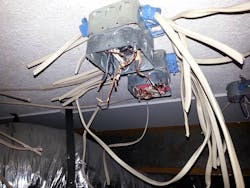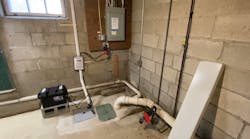All references are based on the 2017 edition of the NEC.
Big Box Problems
Bill Gatewood was kind enough to share this photo with us. According to him, there are eight 6 AWG wires bulging out of this box. Table 314.16(B) specifies that each 6 AWG conductor would need at least 5 cubic inches of volume in the box. That equates to a total of 40 cubic inches needed to properly accommodate these wires. Table 314.16(A) notes that a 411/16-in. × 21/8-in. box would be big enough to accommodate eight 6 AWG wires. However, a 411/16-in. × 1½-in. box would only be able to accommodate five 6 AWG wires. An extension ring could have been used here to increase the overall volume of this enclosure.
Another obvious problem is the lack of a box cover. It was most likely not installed due to the bulging wires. In any case, the missing cover is a violation of Sec. 314.25, which requires a cover, canopy, faceplate, or some other type of covering to be installed on the box to complete the installation.
Although it’s hiding in the background, it appears that the equipment ground is just spliced without being bonded to the box. If so, this violates Sec. 250.148(C), which requires a connection be made from the equipment grounding conductors (EGCs) to the metal box.
Reckless Abandonment
I spotted this mess on the ceiling, which appears to be some temporary wiring abandoned in place. Thankfully, none of this was energized.
As specified in Sec. 90.2(A), temporary wiring installations are supposed to follow the same rules for permanent wiring unless Art. 590 modifies the rules. Ironically, there are no rules in Chapters 1 through 4 for permanent installations that state equipment-like boxes or wiring like NM cables must be removed when the circuit has been discontinued. However, if we look at Sec. 11.1.2.3 of NFPA 1 Fire Code, it states, “Permanent wiring abandoned in place shall be tagged or otherwise identified at its termination and junction points as ‘Abandoned in Place’ or removed from all accessible areas and insulated from contact with other live electrical wiring or devices.” For temporary wiring, NEC Sec. 590.3(D) requires temporary wiring to be immediately removed upon completion of construction or other purpose for which the temporary wiring was installed.
For practical purposes, abandoned wiring or equipment should be removed. Just imagine what would happen if old circuits and equipment were simply abandoned in place repeatedly. Eventually, there wouldn’t be room for us to install new wiring.






